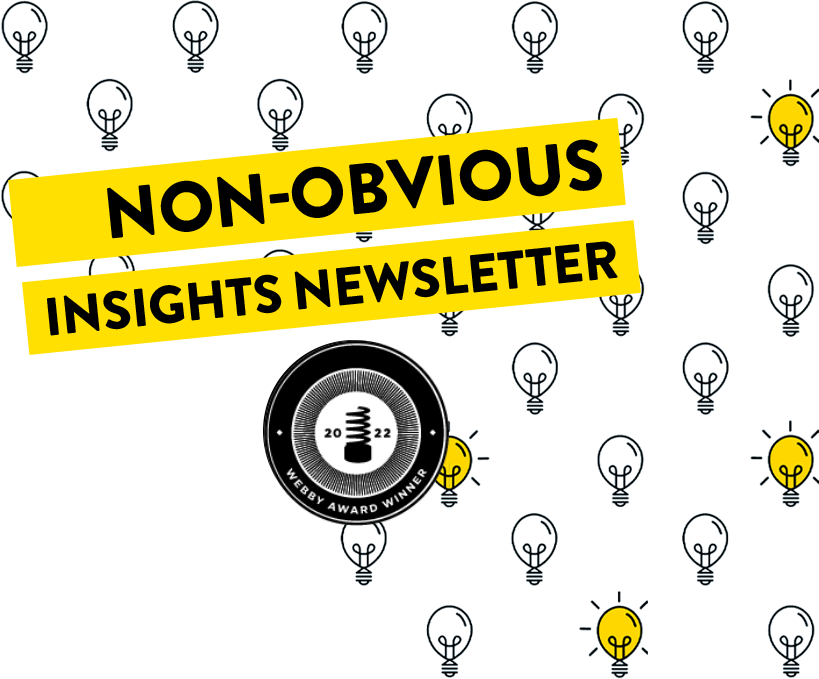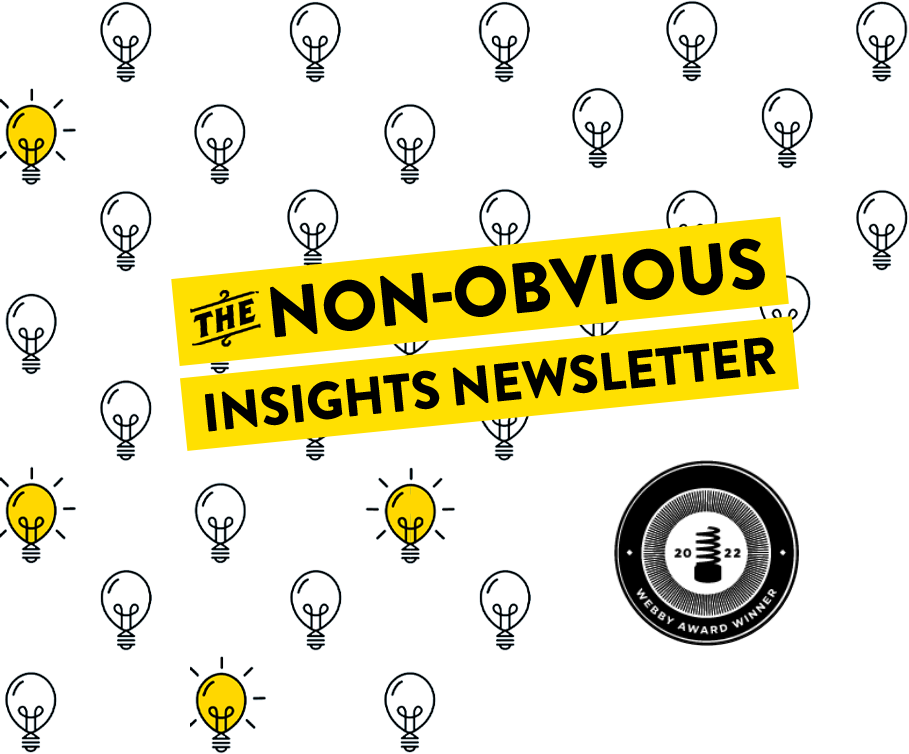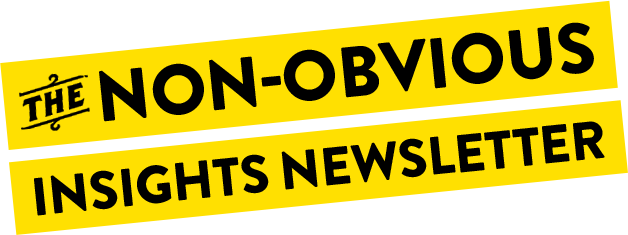Dear Fellow Non-Obvious Thinker,
This week’s Non-Obvious Insights explores the rise of “vibe movie making,” compressing production time and costs while sparking debate about who will remain essential in the future of storytelling. In other stories, you’ll read about how we may be reaching “peak farmland,” allowing us to produce more with less land. Also this week, Anthropic’s $1.5B settlement with authors marks a potential turning point in the long battle over AI copyright and creator compensation. In bonus stories, a book about why trust in science matters, how an 86-year-old musical became the biggest Fall blockbuster and why NFL players are turning to psychedelics as a potential cure for brain injuries.
Enjoy and stay curious!
This Week’s New Videos …
“Vibe Movie Making” and the Real Future of AI In Movie Production
Can AI make a good movie? That question will soon be put to the test as Open AI announced this week that they are backing an animated film called “Critterz” with a targeted release date of May 2026 at the Cannes Film Festival. The film will be made in nine months (as opposed to the typical three years) at a cost of under $30 million (compared to the $100+ million typical budget). The process they are using is increasingly being known as “vibe movie making,” in reference to the speed and automation with which these films are made. The space is growing fast:
“According to new research from FBRC.ai, at least 65 AI-centric film studios have launched globally since 2022, with 30 appearing in 2024 alone. The economics are compelling and dangerous. “Critterz” demonstrates production timelines compressed by 70% and budgets reduced by 75%. For independent creators, AI tools do more than democratizing access to studio-quality production capabilities, it replaces “Lights, Camera, Action” with a prompt.”
As this trend continues, it brings up an interesting case study about what pieces of the process are getting automated first (the animation itself) versus which are the last to be replaced (the film still used a human team to write the screenplay and story). Are the jobs of storytellers more secure than those who bring that story to life on screen? Can a movie ever really be produced at the touch of a button or will it always need some sort of a visionary storyteller at the helm guiding the prompts and controlling the output?
We will see when Critterz comes out in May next year … and it’s unlikely to be the only such project we’ll see in the coming year.
The Future of Agriculture Is Peak Farmland + Growing Reforestation
Today, about half of the world’s land is used for farming. In the future, it could be far less–even as food production increases. As technology improves, we can grow more food on less land. This is leading to what some experts are describing as a “peak farmland” moment where large areas are reforesting, wild animals are returning and we’re turning the clock backwards. It’s not just technology-driven efficiency that is leading to this trend though:
We have also replaced some land-hungry crops with near-landless alternatives: wool and cotton have been to a major extent replaced by synthetic fibres; tobacco is rapidly being replaced by synthetic nicotine; flavourings in food such as vanilla are now largely synthetic; the global caffeine (although not coffee) market is dominated by production in labs; synthetic sweeteners have replaced substantial amounts of sugar cane and sugar beet. We estimate that these synthetic substitutes have spared over 110 million hectares (two Spains) of land from farming.
This broad movement is one that Henry and I first wrote about in The Future Normal and described with the term “Unnaturally Better” which we used to describe a future where our lives can be improved or made more efficient or convenient through artificial means and contrast this with the common belief that natural is always superior. Synthetic fuels, fabrics and food are all growing spaces where we will likely see many more examples of “better” products, which in turn may continue to lead to Earth-shifting trends like reforestation due to hitting peak farmland.
The Long-Awaited AI Copyright Payday May Soon Arrive
For years now, publishers in all categories of media have been fighting a battle with AI firms to be compensated for their content that was used to train large language models. This week there was a big media headline about Anthropic agreeing to a $1.5B settlement to pay book publishers and authors for titles that were illegally used to train AI models. Publishing industry insiders are hoping this may start a wave of similar settlements from other AI companies. There are some nuances behind this ruling, though.
For one thing, it’s only going to include books that were downloaded from illegal websites that had pirated those books in the first place like LibGen (no longer online), but not for books that were purchased and then used for training (which might qualify as “fair use”). Whether you agree or not, this is a story still unfolding in real time. October 10th is the date the judge has set to publish a list of books that will be included in this payout.
Beyond the big story, though, there are other big moves that are shaping this emerging space of how and if publishers get paid licensing fees for their content. The RSL Standard & Collective, for example, allows web publishers to set terms for how AI can use their work and how they get compensated for it. In the process, they remove the argument that AI firms have no way (or terms) for compensating content creators.
If you’re a publisher, this matters a lot … but even if you’re not, this idea that any of us can set terms for how and when we want to be compensated for the things we create and post online should be something we are all invested in seeing happen. As the common online refrain goes, if you’re not paying for the product then you are the product. Getting paid when your content is used that way seems like the least we should all be asking for.
Anonymity Is Dead. Are We All Really Content Now?
A CEO caught on a kiss cam having an affair isn’t just the latest social media story gone unexpectedly viral. It’s also an indication of a potential new future where none of us will be able to enjoy anonymity out in the world, according to a new piece I read this week. It does immediately seem true that if you happen to misbehave in any way publicly, whether being rude to waiter or simply tripping and falling over … it’s increasingly likely that someone will have a camera to capture your lowest moments and potentially turn them into social media fodder. The depressing conclusion that the article’s writer suggests is that there may simply be no way to avoid the unwanted attention:
“Social media has long been a game of roulette with fame at one end and public disgrace at the other … Living in the panopticon means every person you meet is also someone who can ruin your life … Once upon a time, public anonymity protected us; now, it seems, the panopticon’s guards surround you. Everyone is one bad day away from going viral and suffering the fallout. All you have to do is leave your house.”
When celebrities complain about the costs of fame and invasions of privacy from paparazzi, it is easy for many to dismiss. Too bad, they say, but that’s the price of seeking fame. What about the rest of us? While it seems there is no solution here, actually there is. Be deliberate about what you choose not to share. That’s it. If we all did that more often, these stories would lose their virality. And maybe it would be possible to be anonymous again.
The Non-Obvious Media Recommendation of the Week
Aeon
One article explores gaps in the widely accepted Big Bang theory for the origins of the universe. Another explores an abandoned Dominican sugar town from the eyes of a local 12-year-old. If you’re a seeker of unusual and eye-opening stories with a slight philosophical bent, then Aeon should be on your reading list.
“Launched in 2012, Aeon’s mission is to explore and communicate knowledge that helps us make sense of ourselves and the world. We ask the big, existentially significant questions and find the freshest, most original answers, provided by leading thinkers on philosophy, science, psychology, society and culture.”
Alongside your many reading options when it comes to the daily news and stories of the moment, Aeon offers a cleansing chance to add some “big thinking, serious enquiry and a humane worldview” to your weekly reading list.
The Non-Obvious Book of the Week
The Shape of Wonder
A book like this shouldn’t really be necessary. If we all had a shared understanding of why science matters, what it is and all the things scientists contribute to our society (and have for centuries in the past), then many of the arguments in this book would feel obvious and perhaps even repetitive. Unfortunately, our world isn’t that way. Today trust in science itself is routinely undermined by non-scientist personalities who build cults around themselves and encourage the belief that only they can be trusted.
To counter this movement, two renowned physicists teamed up to write this book (just released last week) that offers the most basic of explanations about science, and then goes on to tell the stories of scientists to humanize them as real people with human motivations:
“It strikes us that the lack of understanding of the daily activities, thinking and motivations of scientists may be a factor in the mistrust of scientific information in some of the public today–and in the feeling that many scientists are out of touch with their societies … The mistrust of scientists and their institutions, for whatever reasons, is an urgent problem.”
The one missing element from the book that perhaps could have made the argument even stronger would have been an exploration of the many ethically compromised scientists from history such as Dr. D. Mark Hegsted (paid by the sugar industry to shift public perception) who popularized theories that were later proven to be biased or incorrect and therefore played a role in corrupting faith in science itself. Exploring their shortcomings and how we might uncover or discount such charlatans ourselves would have added a dimension to the arguments of the book.
Despite this small criticism, the biggest theory that The Shape of Wonder effectively proves is that there is a powerful link between how much people trust science and how much they trust the scientists themselves. And that’s unlikely to change.
About the Non-Obvious Book Selection of the Week:
Every week I share a new “non-obvious” book selection. Titles featured here may be new or classic books, but the date of publication doesn’t really matter. My goal is to elevate great reads that perhaps deserve a second look which you might have otherwise missed.
Even More Non-Obvious Stories …
Every week I always curate more stories than I’m able to explore in detail. Instead of skipping those stories, I started to share them in this section so you can skim the headlines and click on any that spark your interest:
- The Fall’s First Blockbuster Is An 86-Year-Old Musical
- The Blind Box Trend Comes to Tech with This Tiny Digital Kodak Camera
- Why Former NFL All-Pros Are Turning to Psychedelics
- The SF Silicon Valley Effect Shaping the Future
- Bad Bunny Says He Skipped the U.S. On Tour Over Concerns That ICE ‘Could Be Outside’ His Concerts
- Junior Ad Jobs Are Vanishing—Can the Industry Rebuild Its Ladder?
How are these stories curated?
Every week I spend hours going through hundreds of stories in order to curate this email. Looking for a speaker to inspire your team to become non-obvious thinkers through a keynote or workshop?
Watch my new 2025 speaking reel on YouTube >>





